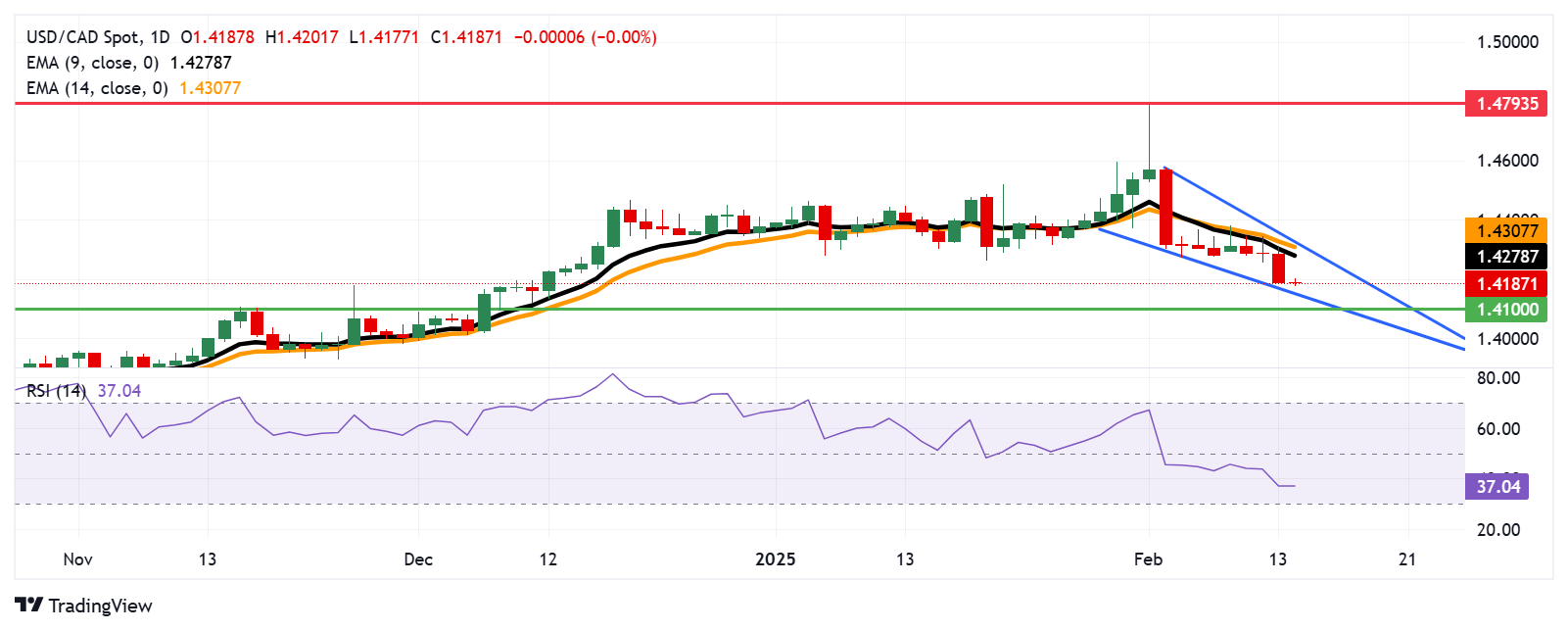USD/CAD Price Forecast: Remains subdued below 1.4200 near falling wedge’s lower threshold
- USD/CAD may test immediate support at the lower threshold of the falling wedge at 1.4160.
- The daily chart technical analysis shows a falling wedge pattern, signaling a potential upward correction.
- The primary resistance appears at the nine-day EMA of 1.4278.
The USD/CAD pair continues its losing streak for the fourth successive session, trading around 1.4190 during the Asian hours on Friday. The daily chart's technical analysis shows a falling wedge pattern, which is a bullish chart pattern that signals a potential breakout to the upside.
Additionally, the 14-day Relative Strength Index (RSI) is approaching the 30 level, reinforcing the prevailing bearish outlook. However, a drop below 30 would indicate an oversold condition for the USD/CAD pair, potentially signaling an upcoming upward correction.
However, the USD/CAD pair continues to trade below the nine- and 14-day Exponential Moving Averages (EMAs), highlighting persistent bearish sentiment and weak short-term price action. This positioning still suggests sustained selling pressure.
On the downside, the USD/CAD pair could find its immediate support at the lower threshold of the falling wedge at 1.4160, followed by the psychological level of 1.4100.
The USD/CAD pair may find immediate resistance around the nine-day EMA at 1.4278, followed by the 14-day EMA at 1.4307. A breakout above these levels may strengthen short-term momentum and support the pair to test the upper boundary of the falling wedge at the 1.4330 level.
USD/CAD: Daily Chart
Canadian Dollar FAQs
The key factors driving the Canadian Dollar (CAD) are the level of interest rates set by the Bank of Canada (BoC), the price of Oil, Canada’s largest export, the health of its economy, inflation and the Trade Balance, which is the difference between the value of Canada’s exports versus its imports. Other factors include market sentiment – whether investors are taking on more risky assets (risk-on) or seeking safe-havens (risk-off) – with risk-on being CAD-positive. As its largest trading partner, the health of the US economy is also a key factor influencing the Canadian Dollar.
The Bank of Canada (BoC) has a significant influence on the Canadian Dollar by setting the level of interest rates that banks can lend to one another. This influences the level of interest rates for everyone. The main goal of the BoC is to maintain inflation at 1-3% by adjusting interest rates up or down. Relatively higher interest rates tend to be positive for the CAD. The Bank of Canada can also use quantitative easing and tightening to influence credit conditions, with the former CAD-negative and the latter CAD-positive.
The price of Oil is a key factor impacting the value of the Canadian Dollar. Petroleum is Canada’s biggest export, so Oil price tends to have an immediate impact on the CAD value. Generally, if Oil price rises CAD also goes up, as aggregate demand for the currency increases. The opposite is the case if the price of Oil falls. Higher Oil prices also tend to result in a greater likelihood of a positive Trade Balance, which is also supportive of the CAD.
While inflation had always traditionally been thought of as a negative factor for a currency since it lowers the value of money, the opposite has actually been the case in modern times with the relaxation of cross-border capital controls. Higher inflation tends to lead central banks to put up interest rates which attracts more capital inflows from global investors seeking a lucrative place to keep their money. This increases demand for the local currency, which in Canada’s case is the Canadian Dollar.
Macroeconomic data releases gauge the health of the economy and can have an impact on the Canadian Dollar. Indicators such as GDP, Manufacturing and Services PMIs, employment, and consumer sentiment surveys can all influence the direction of the CAD. A strong economy is good for the Canadian Dollar. Not only does it attract more foreign investment but it may encourage the Bank of Canada to put up interest rates, leading to a stronger currency. If economic data is weak, however, the CAD is likely to fall.




